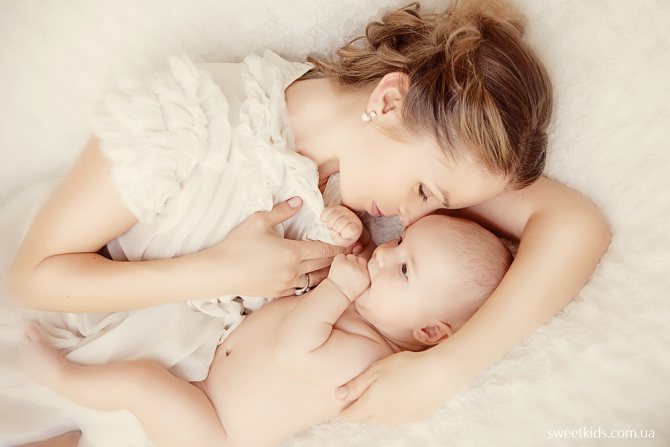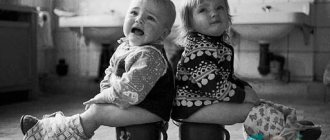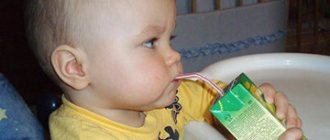No less, and perhaps more important, for him now is to be sure that he is loved, and to learn to love himself. Come on, the skeptical reader will say, can such a baby love? Anna Freud, the daughter of that same psychoanalyst Sigmund Freud, wrote that “the baby does not “love” the mother in the proper sense of the word, but only needs her.”
However, why, then, does he “need” different people in such different ways? Why does he clearly prefer those who not only look after him, but engage in active emotional interaction - attract attention, talk affectionately, smile, play? How and when does a little person develop a feeling of affection and love? This is what we are talking about today.
Guys and animals
Ethologists (scientists who study instincts) argue that various animals develop precisely those behavioral patterns that help them survive in a harsh world. Cubs are born with programmed forms of behavior. One of them is to stay close to their parents, in which case the kids are more protected from dangers.
Australian zoologist Konrad Lorenz noticed that little goslings begin to follow their mother almost immediately after birth. This bond helps adult birds protect and train their young. Dr. Lorenz also discovered that motherless wild goslings, cared for by himself for the first 24 hours of their lives, began to follow him rather than another goose. Sometimes this touching affection caused the scientist certain inconvenience: the goslings even preferred to sleep in his room, instead of settling down on the river bank, as their relatives did.
Here's another interesting example. American psychologist Harry Harlow conducted experiments with baby monkeys. His initial goal was to find out how the learning process occurs in monkeys. For the purity of the experiment, he removed the mother monkey from the cage and began to take care of the little monkeys himself. To his surprise, Harlow discovered that separation from their mother affected the little monkeys in the most negative way. Some of them died. Others were scared, irritable and refused to eat or play. It became clear that monkeys need more than regular feeding to thrive and thrive.
Harlow began experimenting with “surrogate mothers” - various wire structures. One "mother" was supplied with a bottle of food, but the second was not, the third had a "face", the fourth was covered with "fur", and the fifth was only exposed wire. The results were quite impressive. The monkeys were most attached to those “mothers” who were pleasant to cuddle with, i.e. to those that were covered with a warm, soft fleecy cloth. The presence of a milk bottle did not play a role in the development of attachment in the pups. They approached the “cold” metal “mother” to eat, but never cuddled with her, did not hug her, did not express other signs of “love”.
What about human babies?
When small children were miraculously rescued from besieged Leningrad, in the rear they tried to create the best conditions for them, as far as, of course, this was possible for the hard times of war. They had shelter, food, a relatively quiet life, and yet, for unknown reasons, many babies died. Separation from their mother turned out to be unbearable for them.
It turns out that even the little ones have ways to express their love and affection. This, as psychologists say, is signaling behavior - crying, smiling, voice signals, glances. When the baby grows a little, he will begin to crawl like a tail and follow his mother, hug her with his arms, climb on her, i.e. strive for physical contact. Agree that it is difficult to feel emotional closeness to a baby who constantly dodges your hugs. This means that the development of attachment is a system of interactions between mother and child. How does this system develop in the first year of life?
How does the baby feel during childbirth?
Both obstetricians and their patients know very well what a woman experiences at each stage of childbirth. What happens to her baby during birth?
We are quite capable of revealing this secret - with the help of Olga Parshikova, neonatologist, head of the newborn department of the Obstetrics and Gynecology Clinic named after. V.F. Snegireva.
The expectant mother and her baby are one. They live in a common rhythm both during the 9 months of pregnancy and during childbirth. The signal for the beginning of this process is given by the child - normally, birth mechanisms come into play only when all the baby’s systems have already matured and he is completely ready for independent life. Naturally, situations are different, and sometimes the child is forced to hurry up with the birth by some external circumstances (for example, problems with the mother’s health). We’ll talk about how natural childbirth should happen when everything is fine with the baby and his mother. So, when the child is ready to be born, his endocrine system signals this with the help of hormones, and preparations for childbirth begin in the mother’s body. From this moment on, the woman’s task is to help the baby enter a new life. After all, for a child, childbirth is an important process of adaptation to life outside the mother, with a different temperature, pressure, light, sounds, sensations. Whether the baby will easily adapt to unusual conditions depends on how correctly the baby goes through all the stages of childbirth. By the way, for this reason, it is more difficult for baby “Caesareans” who were abruptly “taken out” of their usual conditions to adapt to the new situation.
First period: contractions
At the initial stage, the baby moves from the uterine cavity to its opening cervix and enters the narrow part of the small pelvis. In order for the baby to be healthy, this movement must be unhurried - that’s why it normally takes as long as 6–8 hours.
During contractions, the baby and mother work synchronously: the muscles of the mother’s uterus compress and put pressure on the child, forcing him to move down, and the baby, as it were, “gets ready”, pressing his legs and arms to himself; His heart rate increases and adrenaline is released. To make this serious work easier for the baby, wise nature has provided a number of measures. For example, a natural pain reliever, endorphin hormones, helps relieve a child from unpleasant sensations (they act so effectively that the little one can sleep peacefully throughout the birth). And it is possible to soften the pressure of the uterine muscles on the baby’s body thanks to the cushion of amniotic fluid surrounding the baby in the amniotic sac. When the baby enters the narrow space between the pelvic bones, a protective pad forms on his head - doctors call it a birth tumor. It occurs due to the fact that the subcutaneous fatty tissue on the back of the head and crown swells, and the resulting seal protects the child’s brain from pressure.
During pauses between contractions, the whole family rests. Mom catches her breath, and the baby in her belly can stretch and suck her finger.
During pushing, it is especially important for a mother to properly help her baby. If a woman is too nervous, her muscles contract more and the pressure on the baby increases, and less oxygen reaches him. The little one also experiences a lack of air when the mother “exerts herself too much” at the first stage and does not have the strength to push. Second period: pushing
There is less and less time left before the baby is born: usually the second stage of labor takes about an hour. While helping the child, the woman has to, as obstetricians say, “strain” him. The muscles of the uterus and abdomen make strong squeezing movements (this is pushing), and the pressure on the baby increases significantly. Because of this, the baby shrinks even more - and not in vain: after all, he has to pass through the narrowest area - the pelvic cavity. The widest part of the baby’s body, the head, contracts the most. The soft bones of the skull overlap one another, and because of this, the baby may be born with an elongated or flattened head. The baby’s torso also “compacts,” especially the chest. And here the amniotic fluid helps the baby: like a buffer, they make its movement towards the “exit” softer and safer. As soon as the baby's head comes out, the most important part of the work will be behind him - the shoulders, arms, torso and legs will appear much faster.
After birth
The baby greets the beginning of a new life with a loud cry. This is a natural (as doctors say, a reflex) reaction of his body to a sudden change in conditions. First of all, for the cold, because the temperature of the amniotic fluid is 37–38 °C, and outside, in the maternity ward, it is no more than 24 °C. Secondly, to bright light: let’s not forget that the child lived in complete darkness for all 9 months. But, more importantly, a cry is a response to the baby’s first breath, irritating the child’s lungs and airways that are unusual for this. The deeper the breath, the louder the little one screams. At the same time, thanks to this, the fetal fluid that filled them before birth is released from the lungs.
In order for the newborn baby to calm down, he is immediately placed on his mother’s chest, and the baby, hearing her heartbeat, immediately calms down. The first drops of colostrum are dripped into the baby's mouth and allowed to hold the nipple. Immediately after birth, the baby cannot yet suckle, and in the first day he does not need to. A few drops of colostrum, rich in nutrients and protective substances, serve as food for the baby, help protect it from infections and populate its intestines with beneficial microorganisms.
As soon as the baby is born, he falls into the caring hands of a midwife and neonatologist. The newborn is immediately placed on a sterile diaper under a warm lamp so that he does not freeze due to the temperature difference. The baby takes his first breath and screams at the top of his voice, and the midwife then cuts off his umbilical cord. Then she drains the baby’s body with napkins, removes particles of mucus, blood, and amniotic fluid from the skin and places the clean baby on the mother’s chest. Following this, the child is examined by a neonatologist and records data on his condition at the 1st and 5th minute of life - gives him an Apgar score. The baby is wiped with sterile oil, a clamp is placed on the umbilical cord, albucide is dripped into the eyes, and the genitals of girls are treated with a disinfectant solution. The final touch is that the baby is dressed in sterile underwear and handed over to the mother.
Immediately after birth, the baby’s body begins to energetically free itself from traces of its “past life.” The baby sneezes, clearing his nose of mucus; vomits amniotic fluid, which he swallowed in his mother’s belly; makes his first “big” toilet. Within a few hours, the baby’s birth swelling subsides, and the head takes on a normal shape.
The child’s organs and systems are gradually learning to work in a new mode: breathing is established, the heart changes its structure (after all, now the process of blood circulation occurs not through the placenta, but independently). Birth opens up a lot of new abilities in a baby. He begins to hear and see - the baby was able to do this even before he was born, but only now the visual and auditory images have become truly clear and loud. The unknown world gives the baby new sensations, because now he is surrounded not by warm water, but by diapers and feels many affectionate touches, among which he unmistakably recognizes the most important ones - his mother's.
The stone-faced experiment - what do we expect from each other?
Several mothers (or fathers) with their three-month-old children gathered in the psychologist’s laboratory. First, parents were asked to play with their children as they usually do. In different pairs (parent + child), the game proceeded differently: for some it was calm, for others it was more active. When the kids needed a break from active activities, they briefly turned away or closed their eyes.
At this moment, the psychologist asked the mother to stop communicating with the child. The instructions were as follows: continue to look at the baby, but give your face a frozen, “stony” expression. This surprised the baby, and he tried to influence the parent with a smile, humming, and physical activity. However, the parent continued to maintain a stony expression on his face during these attempts. After a few minutes, the kids' behavior began to change. They turned to the side, began to suck their thumb, and resentment and misunderstanding froze on their faces. Some children reacted to the parent's indifference with whimpering, turning into bitter continuous crying. After all, the mother, although she remained close, against all the child’s expectations, became emotionally unavailable. At the end of the experiment, the parent resumed normal play with the child until the child returned to a good mood.
What does this experiment say?
A three-month-old baby is determined to interact; he definitely needs an adult’s reaction to his seemingly meaningless smiles and coos. Therefore, the meaning of these smiles is social contact! If the mother is depressed and the “stony”, indifferent expression (“depressive mask”) does not leave her face, the baby will inevitably feel that his calls remain unanswered. By the way, it has been found that children whose mothers suffered from postpartum depression are more prone to aggressive and antisocial behavior later on.
When does a child begin to recognize his mother?
Already in the prenatal period, the fetus develops the nervous system, the main sensory organs and movements. A child is born with already formed hearing, visual sensations and the necessary elementary reflexes. The newborn does not yet accurately perceive the colors and shapes of the objects around him, but reacts vividly to large and bright, moving and luminous objects. He may also begin to listen carefully if his mother starts talking to him in a whisper.
When does a child begin to recognize his mother? His recognition reflexes begin to develop intensively closer to four weeks: he begins to perk up when he feels a person approaching, and smiles with the so-called “angel smile,” that is, purely reflexively. The baby does not yet understand who approached him, but he is already reacting to the person in his own way.
At the age of three months, babies already begin to fix their eyes on an object for some time and are able to look at a space within a radius of up to 4 meters. They also carefully examine the objects that come into their hands and actively react to them. If such a baby is raised in a vertical position, he will carefully examine the face of the person in front of him.
What is the baby afraid of?
In pediatrics and psychology there is the concept of “anxiety in seven-month-old children.” At this age, an interesting change occurs with babies. If up to 6-8 months they smiled at everyone, were friendly and open, then from now on they suddenly become timid and wary in the presence of strangers.
Here, for example, are the impressions of Lena, mother of six-month-old Anyuta:
“The doctor recommended giving my daughter a massage course. It turned out that it is much more difficult than at three months! While Anya is in my arms, she still graciously agrees to “say hello” to her aunt, but begins to scream as soon as she takes her in her arms. Anya never wants to be alone with the masseuse. Nobody scared my daughter, and we were never separated for a long time. And Anyuta began to treat my friends and even my grandparents very warily. And they are offended, they say, our granddaughter doesn’t love us...”
Meanwhile, this is a completely normal phenomenon, it indicates a new ability of the baby - from now on he distinguishes familiar phenomena from unfamiliar ones. The child begins to realize: the presence of a close adult means safety. Hence the anxiety and fear when mom leaves.
With mom - on the same wavelength
Here is another interesting experiment, this time with nine-month-old babies. Together with their mothers, they were supposed to meet a stranger for the first time. The adults, as usual, exchanged greetings when they met. Some mothers were given the task of saying the traditional greeting “Good day!” anxiously (with furrowed eyebrows, wide-open eyes and expressing concern with all his appearance). Other mothers had to say the same words “Good day!”, but with a smile on their face and with a friendly intonation. As expected, the infants accurately read their mothers' signals. Children whose mothers showed joy behaved more confidently with the stranger, smiled more often and cried less often when the stranger picked them up.
So, it’s not enough for your baby to just eat and sleep. He is able to feel subtly, he can and wants to learn to love! His emotions and impressions today will determine your relationship for life. And your task is to support the baby with your love, give him confidence in his own abilities, give him a feeling of freedom and security, and make your mutual communication exciting and joyful. What is needed for this?
Sees mom and recognizes
Children's vision does not develop as actively as hearing; in the first months, the child sees everything as if in a fog, he does not recognize the silhouettes of his parents.
He doesn’t care who passed next to him: dad or a stranger. However, gradually, starting from three months, the baby’s world begins to acquire colors, he notices who exactly is with him most often, who plays with him, who smiles at him. The baby begins to respond very well to facial expressions and smile back at his parents.
At 4-5 months, a child, at the sight of a familiar person, may begin to walk, smile, twitch his legs and arms, provided that this person smiles joyfully at him and calmly speaks.
By the age of six months, children should already be able to clearly distinguish between friends and strangers. They may even avoid strangers, behave awkwardly, not play or smile. Our son at 6 months was the same: he constantly laughed with us, played, showed what he could do, twitched his legs, etc. As soon as they brought him to his grandmother, he immediately became a different child, with a sad look and a minimum of movements, and behaved warily.
Breastfeed your baby!
Breastfeeding gives mother and baby a unique experience of love and trust that lasts a lifetime. Try to do everything in your power to breastfeed your baby. Let the baby have the opportunity to kiss his mother’s breast at any time, and not when “the time has come.” After all, now it’s no secret to anyone that sucking the mother’s breast not only satisfies hunger, but also gives a feeling of peace, security and even helps to cope with pain. This is physical contact, visual and emotional. With what gratitude and delight the sucking baby looks at his mother, and how much tenderness and affection she gives him at this moment!
Does the baby hurt during childbirth?
According to scientists, a child is able to feel pain from the 20th week of pregnancy. But the position in which he is born protects the child very well from unnecessary discomfort; his arms and legs are tightly tucked into the body. Therefore, he will not feel pain, but shock cannot be avoided - after giving birth, a very cold and bright world awaits him, air, sharp sounds and a lot of unusual things.
Let us remind you that we previously wrote about which stars will soon become mothers - the birth is already approaching. The names of these lucky girls can be read at the link.
Also, read that the midwife paused her labor to help another woman give birth.
Material prepared by Karina Khustochkina
Read more interesting materials on Clutch!
Chat with your baby!
Call him by name more often, talk about how good, handsome, and beloved he is. You can sing, you can comment on what is happening around you. Try to understand what exactly interested your child, what he looked at - at a picture hanging on the wall, or at a dog that ran past you, or maybe at his own tiny fingers. Be sure to tell him about this. Comment on your actions: now we will change your diaper, and now we will put on your pants. So, they put it on the right leg, now on the left. Now let’s put on red socks, etc.
You may find it difficult at first to speak “into the void” and seemingly not hear any response to your speech. However, after pausing, take a closer look at the baby. At some point, he will definitely try to answer you - whether with a smile, babble or active body movements. Your task is to learn to “decipher” these messages. You will notice that the baby will agree with some of your proposals, but will respond to others with a decisive refusal.
From birth to 6 months: a companion for everyone
A newborn child cannot understand from the very beginning how the world works. Every time his mother takes him in her arms, the baby recognizes her smell, touch, voice, and soon begins to understand that caresses and feeding follow.

Thus, the child brings his mother into the confines of his small world. He can distinguish her from other people by her voice, smell, and affectionate touches.
At about 3 months, the child clearly recognizes her face, in which previously he only caught familiar features. He also responds animatedly to his mother’s approach, distinguishing her from other people. However, throughout the entire six months the child is friendly and smiles at everyone, and also allows everyone to hold him.
It gives parents special pleasure to hear from friends about how friendly their child is. However, against the backdrop of general friendliness, the child gradually becomes more and more attached to his mother.











